
International Research Journal of Engineering and Technology (IRJET) e-ISSN:2395-0056 Volume: 11 Issue: 03 | Mar 2024 www.irjet.net p-ISSN:2395-0072
ONLINE VOTING SYSTEM with MULTIPLE SECURITY LAYERS
Akash
Shukla1 , Anshika Singh2 , Dr. Ashish Baiswar3
1UG student of Department of Information Technology, Shri Ramswaroop Memorial College of Engineering and Management Lucknow, Uttar Pradesh, India
2UG student of Department of Information Technology, Shri Ramswaroop Memorial College of Engineering and Management Lucknow, Uttar Pradesh, India
3Associate Professor, Department of Information Technology, Shri Ramswaroop Memorial College of Engineering and Management Lucknow, Uttar Pradesh, India
Abstract- Today's digital society embraces increasing transformation in technologies. With these advancements, comes the concern regarding security and accuracy. This paper considers the same and put forth the solution of the concerns. It investigates the architecture, functionality and security of an online voting system. It considers the architectural design of the system, primarily focusing on the integration of strong security mechanisms. Top priorities of the system include biometric authentication and secure user identification. The study also includes barcode technology, facial recognition, and OTP verification in order to improve system integrity.
1. INTRODUCTION
A series of major changes can be seen in many areas includingtheconductofdemocraticelections.Thepossible reason largely include the global shift towards the technological integration. This paper presents an innovativeonlinevotingsystem whichis basedonDjango, MySQL, HTML, CSS and JavaScript with multiple layers of security.Thesystemisanintegrationofbiometrics,secure user authentication, OTP verification[3], facial recognition using dlib library, barcode recognition OpenCV and Pyzbar library [4], and more to ensure the integrity and credibility of the voting process. The system works to improve the reliability and effectiveness of voting system inthedigitalage.
2. EXISTING SYSTEM
EVMs(Electronic Voting Machines) form the foundation of primary voting system but have concerns including possibility of tampering, their security and absence of thorough electoral control. Even programs like VVPAT(Voter Verifiable Paper Verification) which aims to promote transparency fails to convince people with its securityandopenness.Although,existingelectoralsystems are widely used , yet face constant criticism. They need to guarantee democratic processes by being more
transparent and credible. Another major issue with traditional systems is the accessibility. People residing outside the country, disabled people, undercover agents, etc fail to cast their vote as they are unable to reach the pollingbooths.
3. PROPOSED SYSTEM
The proposed system for online voting has multiple security layers which helps to strengthen the election process. The system strongly emphasize on uncompromising security measures by using Django for back-end, MySQL for database, and HTML, CSS, JavaScript for front-end development. It also offers secure user authentication by using OTPs(One Time Passwords), biometric verification like facial [2],[3] recognition using dlib library and barcode voting ID verification using OpenCVandPyzbarlibrary
The described security measures are taken in order to maketheonlinevotingplatformuser-friendly,transparent, accessible,andcredible.
4. OBJECTIVE
The foremost aim of the project is to design and develop a sophisticated online voting system whichincludesawiderangeofsecuritylayers.
The system seeks to enable voter ID and Aadhaar cardauthenticationalongwithgatheringpersonal information and password creation to streamline userregistrationprocess.[1]
It uses authentication technology that includes facerecognitionandvoterIDbarcodescanning.
It aims at providing a safe user login process that combines registration credentials with OTP(One TimePassword)verification[3]
It also intends to put in place a framework for voters in order to keep the track of number of votescasted.

Volume: 11 Issue: 03 | Mar 2024 www.irjet.net p-ISSN:2395-0072
5. SCOPE
Providinga safeandeasytousesystemforonline votingistheprimarygoaloftheproject.
It also aims at providing several security features whichincludefacialrecognition,barcodescanning andOTP verificationin ordertomaketheprocess ofuserauthenticationmorereliable
It will also enable users for distant voting meanwhile ensuring scalability, dependability, credibility. Other aspects include creation of effective,easilyaccessible,user-friendlysystemfor online voting along with supporting real-time voterparticipationtracking.
CSRF token is used in the application in order to mitigate CSRF (Cross-Site Request Forgery) attacks. The combined mechanism of CSRF token andserversidevalidationhelpstoensurethatthe requests accepted are legitimate and from the sameuser'ssessionandwebsite.
6. METHODOLOGY
6.1
Iterative Waterfall Model
The development approach for the proposed systemischosentobeiterativewaterfallmodel.It is an extension of traditional waterfall model. It priortisesmethodologicaldevelopmentindiscrete steps. This process of development starts with a feasibilitystudywhichcoversallthethreeaspects including technical, operational and economical. Next phase is the requirement gathering and anlaysisfollowedbythedesignphase.
The project can be readily modified as this approach of development is iterative and thereby backtracking the phases is possible unlike in the traditional waterfall model, hence the changing requirementsoftheprojectcanbeaccomodated.
Afterwards,theapplicationistested,deployed and put into use in order to guarantee user response.Thesalientfeaturesofthemodelinclude testing,stakeholderinteraction,andintegrationof robust security measures at every stage which helps the developers identify the issues early and reactquicklyforthechangingrequirements.
6.2 Avantages of the Development Model
The iterative waterfall model's merits come from its iterative nature, which allows for alterations and enhancements at any phase of the
development process as per the changing requirementsoftheclients.
Early testing and stakeholder engagement enable toidentifyproblemsandintegratecontinualinput
It also emphasizes periodic security tests and upgrades, ensuring strong security controls throughoutthedevelopmentprocess.
Thisiterativeprocessreducesdocumentationtime while increasing design refinement time, allowing for early problem detection, continual improvement, and seamless adaptation to changingprojectneeds
Every iteration is itself a mini-cycle of development, hence includes all the phases namely planning, designing, coding, testing, and deployment. Thereby risks can be identified at early stages only and hence overall risk of the projectcanbereduced.
While the development process, clients and endusers are in constant interaction with the developers hence it makes sure that the final product so developed is closely aligned with the expectationsoftheusers.
6.3 Dlib Library
DlibisaversatileC++librarywhichhasvariousprominent capabilitiesincludingimage processing,computer vision, machinelearning,etc.Ithasbeenprovedtobeapowerful toolwhenitcomestofacedetectionandrecognitiondueto itsrobustfeatures.
For face detection, a HOG(Histogram of Oriented Gradients)[6] descriptor is employed by the module. This helps in accurately detecting faces in images even if the lighting is not sufficient, facial expressions or poses are changing or varying. Dlib is a module that helps to represent facial features in the form of numerics by using deep metric learning techniques. The generated embeddings capture the characteristics which are unique therebyhelpingincomparisonandidentification.
A pre-trained deep neural network is employed for the computation of face embeddings which processes the images through mutiple layers. This is done by feeding alignfaceimagesthroughthenetwork.Ahighdimensional numerical format is used to represent the unique facial features. Furthur, these face embeddings can be used to recognise or verify bycomparing them with a database. It can be widely used in applications which may include various tasks such as face alignment, emotional analysis, videosurveillance,etc.

International Research Journal of Engineering and Technology (IRJET) e-ISSN:2395-0056
Volume: 11 Issue: 03 | Mar 2024 www.irjet.net p-ISSN:2395-0072
6.4 OpenCV and Pyzbar Library
The web application consists of a barcode recognition feature which decodes the barcode and verifies whether the user is valid or not.This feature is built using OpenCV andPyzbarlibraries.
OpenCV[4],[5]orOpenSourceComputerVisionLibraryis a robust library which is widely used in image processing and computer vision tasks.It is used in the application to handle the input image of the barcode in real time when theuserscansthebarcodeofhisvoterIDcard.Itprocesses theimageandthenpassesitfortherecognitionprocess.
For the recognition process of the barcode, Pyzbar library[4], which is a Python library is used.It takes the image processed by OpenCV as input and decodes it.Thereby it extracts the relevant information in order to complete the user verification process.This process is efficient,ultrasmoothandaccurate.
7. SYSTEM DESIGN
7.1 E-R Diagram
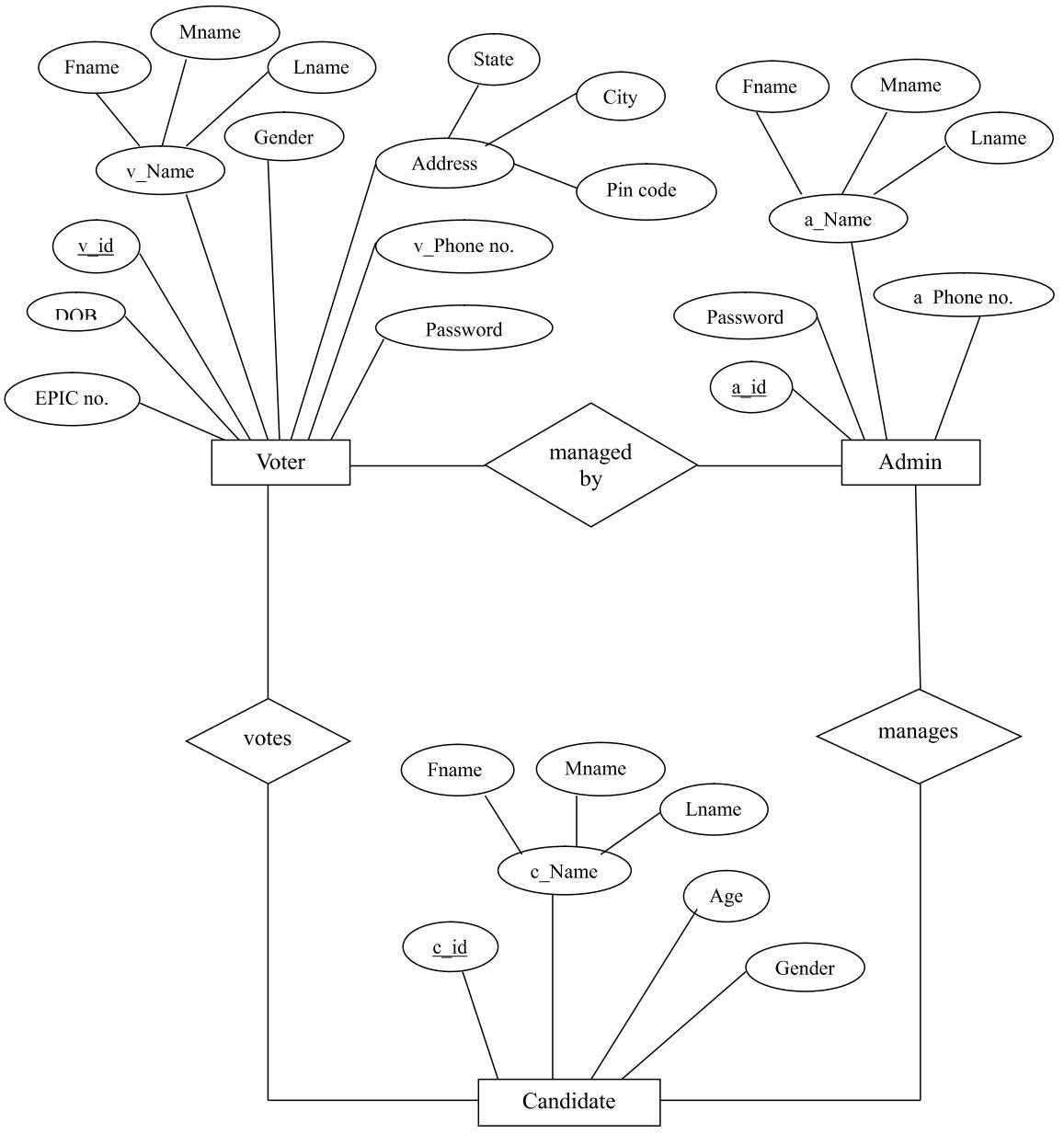

International Research Journal of Engineering and Technology (IRJET) e-ISSN:2395-0056
Volume: 11 Issue: 03 | Mar 2024 www.irjet.net p-ISSN:2395-0072
7.2 Use Case Diagram
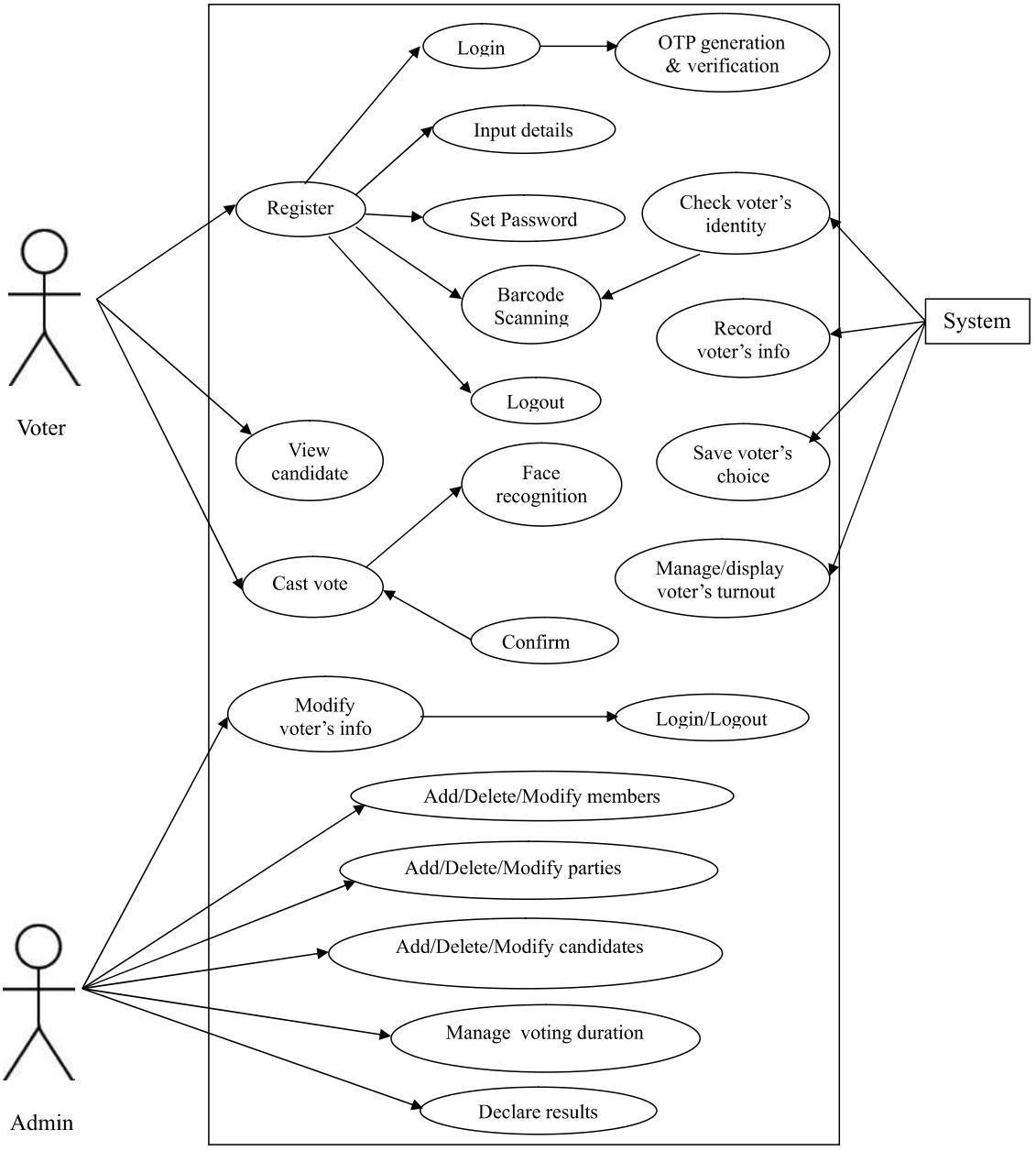
2UseCaseDiagram

International Research Journal of Engineering and Technology (IRJET) e-ISSN:2395-0056
Volume: 11 Issue: 03 | Mar 2024 www.irjet.net p-ISSN:2395-0072



International Research Journal of Engineering and Technology (IRJET) e-ISSN:2395-0056
Volume: 11 Issue: 03 | Mar 2024 www.irjet.net p-ISSN:2395-0072
8. IMPLEMENTATION
1. Onviewingthewebapplication,userwillbeabletoseethehomepagewherehe/shecanopttosign-uporsign-in orviewthevoters’turnout

2. Newusersarerequiredtoregisterthemselvesbygivingtheirpersonaldetails Whileregistering,userrequiresto verifytheOTPandcapturefaceforlaterverification.
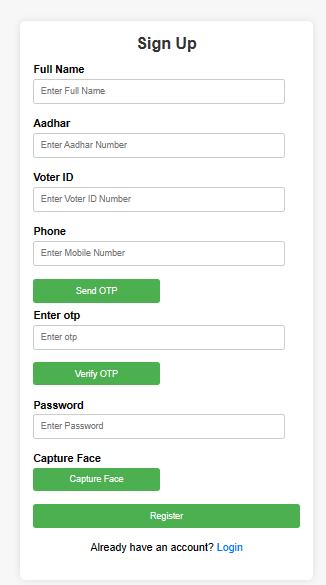
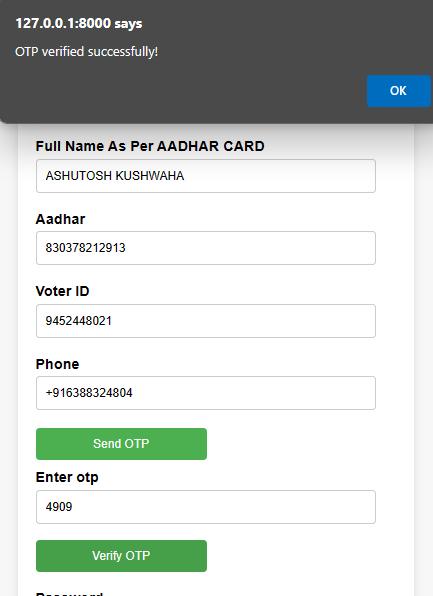

International Research Journal of Engineering and Technology (IRJET) e-ISSN:2395-0056
Volume: 11 Issue: 03 | Mar 2024 www.irjet.net p-ISSN:2395-0072

3. Onsuccessfulregistrationoftheuser,he/shewillbedirectedtotheloginpage.Tologin,userrequirestoenterthe aadhaarno.andpassword.


International Research Journal of Engineering and Technology (IRJET) e-ISSN:2395-0056
Volume: 11 Issue: 03 | Mar 2024 www.irjet.net p-ISSN:2395-0072
4. Afterlogin,barcodeofthevoterIDcardhastobescannedandverified.
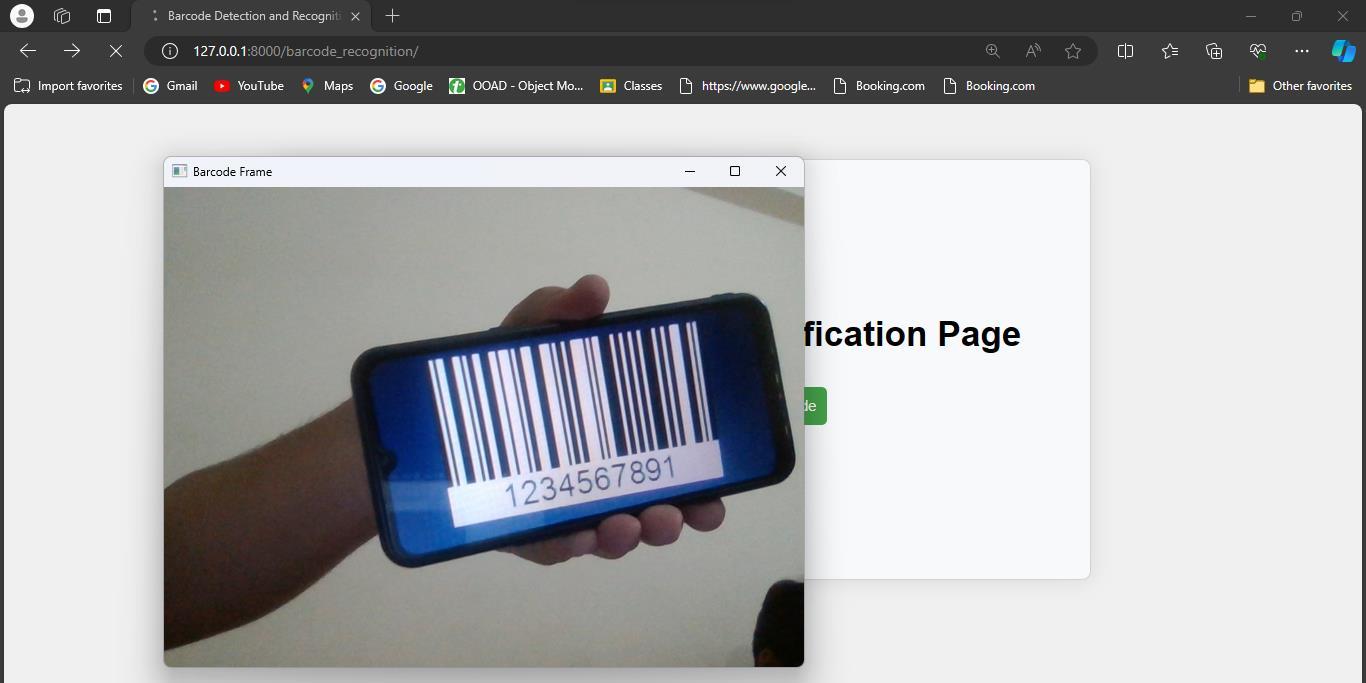
5. Afterthat,userhastoverifyhisfacewhichwillbematchedwiththepicturestoredatthetimeofregistration

6. On successful verification of the face and the barcode, user will be directed to the page where he can cast his vote(onlyonce).

International Research Journal of Engineering and Technology (IRJET) e-ISSN:2395-0056
Volume: 11 Issue: 03 | Mar 2024 www.irjet.net p-ISSN:2395-0072
9. SYSTEM REQUIREMENTS
9.1 for Developers
Hardware Platform: 5th Gen or newer Intel/Ryzen processor, 4 GB or higher RAM, minimum 2 GB free disk space
Software requirements: Visual Studio Code, JetBrains WebStorm, or Eclipse for web development; MySQL, PostgreSQL, or MongoDB for storing user data, candidate info,andvotingrecords, Django,PHP,etcforbackend. OperatingSystem: Windows7orlater(32-bitor64-bit)
9.2 for Users
Hardware Platform: Core i3 or better processor, 2 GB or higherRAM
Software requirements: Windows 7 or later, Chrome for browsing
10. SYSTEM FLOW
Processstartswiththeregistrationoftheuseriftheuseris new to the web application. User requires to fill up the registration form[1] with the details including the name, phoneno.,aadhaarno.,voterIDno.,pancardno.,etc.
Registration process is finalised by clicking user’s image for verification in the next step and by OTP verification[3].If the user is one the existing user, he/she cansimplyloginusinghis/hercredentials.Thisisfollowed byOTPverification.


International Research Journal of Engineering and Technology (IRJET) e-ISSN:2395-0056
Volume: 11 Issue: 03 | Mar 2024 www.irjet.net p-ISSN:2395-0072
Afterwards, the next step is for facial recognition[2],[3] of the user. For this, user requires to capture his/her picture in real time. This picture is then matched with the one stored in the database at the time of registration. If the picture is a match, user can move to the next step , otherwisehehastorecapturethepicture.
Facial recognition is followed by the barcode detection. After the successful facial recogniton process, barcode present on the voter ID card has to be verified. For this, user has to scan his voter ID card’s barcode using the camera of his device. Once recognised, user can cast his/hervotetothecandidateofhis choice. Castingofvote hastobedonewithin1minute.Thistimeristoensurethat thereis leastor no chance ofmalpractices. After that user canlogout.
Voter turnout can be viewed by anyone. One viewing the turnoutneednottobeaneligiblevoterortobeanexisting useroftheapplication.
11. RESULT
The online voting system is an effective way to conduct elections digitally due to its security, scalability, accessibility and user-friendliness. This system is a successful integration of OTP verification, biometric verificationandbarcoderecognitionthathelpsinensuring enhanced integrity and confidentiality of the voting process. On whole, this system is potent enough to add to efficiency and transparency of the electoral process along withremarkablyreducingthemalpractices.
12. CONCLUSION
Thedevelopmentapproachofthesystemforonlinevoting which has multiple security layers, requires to be structured and carefully done. The chosen development modelisiterativewaterfallasitworksasarobustsoftware development method providing systematic steps which thereby ensure the security, reliability and adaptability of the system. Since, the project aims at creating an efficient andsecureonlinevotingplatformhence,thisdevelopment is carefully followed. It also emphasizes on strict security measures in every development phase to prevent and handle risks associated with it. This facilitates in early error detection, required modifications, and seamless adaptation to changing requirements and thereby the reliabilityandsecurityisenhancedfurthur.
Through this project, we aim at providing an online platform for voting which adheres to the security standards along with meeting the operational requirements. Since it facilitates in remote voting hence
enables expatriates, the disabled, and military personnels to vote securely from anywhere. It can be utilised to hold emergency elections. Being easily accessible, this system will help in increasing the participation of people in electoral processes. This system ultimately contributes to thereliabilityandintegrityoftheelectoralprocess.
REFERENCES
[1] Anisaara Nadaph, Rakhi Bondre, Ashmita Katiyar, Durgesh Goswami, Tushar Naidu "An Implementation of SecureOnlineVotingSystem"
[2] L.Vetrivendan, Dr. R.Viswanathan, J.Angelin Blessy "SmartVotingSystemSupportthroughFaceRecognition"
[3] Sakshi Meher, Pradnya Muley, Sayali Pawar, Apurva Solanke "Smart Online Voting System Using OTP AuthenticationandFaceRecognition"
[4] Abin Benny's project report "Detecting QR Code and BarCodeusingOpenCVandPyzbar"
[5]RamadanTH.Hasan,AmiraBiboSallow"FaceDetection andRecognitionUsingOpenCV"
[6]https://pyimagesearch.com/2021/04/19/facedetection-with-dlib-hog-and-cnn/
